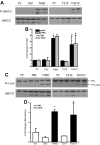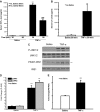Trauma and hemorrhage-induced acute hepatic insulin resistance: dominant role of tumor necrosis factor-alpha
- PMID: 18187553
- PMCID: PMC2329283
- DOI: 10.1210/en.2007-0922
Trauma and hemorrhage-induced acute hepatic insulin resistance: dominant role of tumor necrosis factor-alpha
Abstract
It has long been known that injury, infections, and other critical illnesses are often associated with hyperglycemia and hyperinsulinemia. Mortality of critically ill patients is greatly reduced by intensive insulin therapy, suggesting the significance of reversing or compensating for the development of acute insulin resistance. However, the development of acute injury/infection-induced insulin resistance is poorly studied, much less than the chronic diseases associated with insulin resistance, such as type 2 diabetes and obesity. We previously found that insulin resistance develops acutely in the liver after trauma and hemorrhage. The present study was designed to begin to understand the first steps in the development of trauma and hemorrhage-induced acute hepatic insulin resistance in an animal model of injury and blood loss similar to traumatic or surgical injury and hemorrhage. We present novel data that indicate that hepatic insulin resistance increased dramatically with an increasing extent of hemorrhage. With increasing extent of blood loss, there were increases in serum TNF-alpha levels, phosphorylation of liver insulin receptor substrate-1 on serine 307, and liver c-Jun N-terminal kinase activation/phosphorylation. Exogenous TNF-alpha infusion increased c-Jun N-terminal kinase phosphorylation and insulin receptor substrate-1 serine 307 phosphorylation, and inhibited insulin-induced signaling in liver. Conversely, neutralizing TNF-alpha antibody treatment reversed many of the hemorrhage-induced changes in hepatic insulin signaling. Our data indicate that the acute development of insulin resistance after trauma and hemorrhage may have some similarities to the insulin resistance that occurs in chronic diseases. However, because so little is known about this acute insulin-resistant state, much more needs to be done before we can attain a level of understanding similar to that of chronic states of insulin resistance.
Figures










Similar articles
-
Tissue-specific difference in the molecular mechanisms for the development of acute insulin resistance after injury.Endocrinology. 2009 Jan;150(1):24-32. doi: 10.1210/en.2008-0742. Epub 2008 Sep 18. Endocrinology. 2009. PMID: 18801909 Free PMC article.
-
Mechanisms of hemorrhage-induced hepatic insulin resistance: role of tumor necrosis factor-alpha.Endocrinology. 2004 Nov;145(11):5168-76. doi: 10.1210/en.2004-0524. Epub 2004 Aug 5. Endocrinology. 2004. Retraction in: Endocrinology. 2021 Oct 1;162(10):bqab124. doi: 10.1210/endocr/bqab124. PMID: 15297437 Retracted.
-
Infliximab restores glucose homeostasis in an animal model of diet-induced obesity and diabetes.Endocrinology. 2007 Dec;148(12):5991-7. doi: 10.1210/en.2007-0132. Epub 2007 Aug 30. Endocrinology. 2007. PMID: 17761768
-
The role of TNF-alpha in insulin resistance.Endocrine. 2004 Mar-Apr;23(2-3):177-82. doi: 10.1385/ENDO:23:2-3:177. Endocrine. 2004. PMID: 15146098 Review.
-
TNF-alpha and insulin resistance: summary and future prospects.Mol Cell Biochem. 1998 May;182(1-2):169-75. Mol Cell Biochem. 1998. PMID: 9609126 Review.
Cited by
-
Role of inhibitory κB kinase and c-Jun NH2-terminal kinase in the development of hepatic insulin resistance in critical illness diabetes.Am J Physiol Gastrointest Liver Physiol. 2011 Sep;301(3):G454-63. doi: 10.1152/ajpgi.00148.2011. Epub 2011 Jun 16. Am J Physiol Gastrointest Liver Physiol. 2011. PMID: 21680774 Free PMC article.
-
Role of tissue macrophages in the development of critical illness diabetes.Shock. 2012 Jan;37(1):70-6. doi: 10.1097/SHK.0b013e31823180a4. Shock. 2012. PMID: 21841539 Free PMC article.
-
Injury-induced insulin resistance in adipose tissue.Biochem Biophys Res Commun. 2012 May 11;421(3):442-8. doi: 10.1016/j.bbrc.2012.03.146. Epub 2012 Apr 13. Biochem Biophys Res Commun. 2012. PMID: 22521887 Free PMC article.
-
Acute psychological stress results in the rapid development of insulin resistance.J Endocrinol. 2013 Apr 15;217(2):175-84. doi: 10.1530/JOE-12-0559. Print 2013 May. J Endocrinol. 2013. PMID: 23444388 Free PMC article.
-
Tissue-specific difference in the molecular mechanisms for the development of acute insulin resistance after injury.Endocrinology. 2009 Jan;150(1):24-32. doi: 10.1210/en.2008-0742. Epub 2008 Sep 18. Endocrinology. 2009. PMID: 18801909 Free PMC article.
References
-
- Del Aguila LF, Krishnan RK, Ulbrecht JS, Farrell PA, Correll PH, Lang, CH, Zierath JR, Kirwan JP 2000 Muscle damage impairs insulin stimulation of IRS-1, PI 3-kinase, and Akt-kinase in human skeletal muscle. Am J Physiol Endocrinol Metab 279:E206–E212 - PubMed
-
- Chaudry IH, Sayeed MM, Baue AE 1974 Insulin resistance in experimental shock. Arch Surg 109:412–415 - PubMed
-
- Ikezu T, Okamoto T, Yonezawa K, Tompkins RG, Martyn JA 1997 Analysis of thermal injury-induced insulin resistance in rodents. Implication of postreceptor mechanisms. J Biol Chem 272:25289–25295 - PubMed
-
- Carter EA 1998 Insulin resistance in burns and trauma. Nutr Rev 56(1 Pt 2):S170–S176 - PubMed
-
- Van den Berghe G, Wouters P, Weekers F, Verwaest C, Bruyninckx F, Schetz M, Vlasselaers D, Ferdinande P, Lauwers P, Bouillon R 2001 Intensive insulin therapy in the critically ill patients. N Engl J Med 345:1359–1367 - PubMed
Publication types
MeSH terms
Substances
Grants and funding
LinkOut - more resources
Full Text Sources
Medical
Molecular Biology Databases
Research Materials
Miscellaneous

